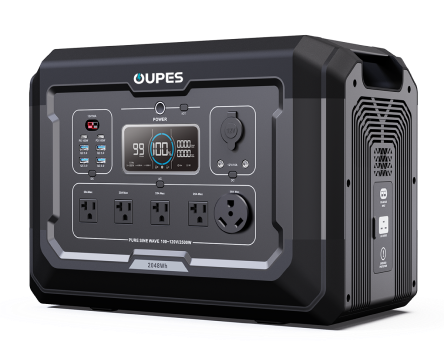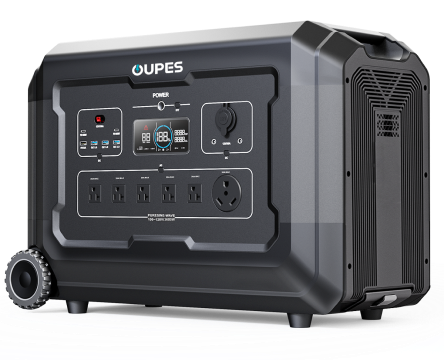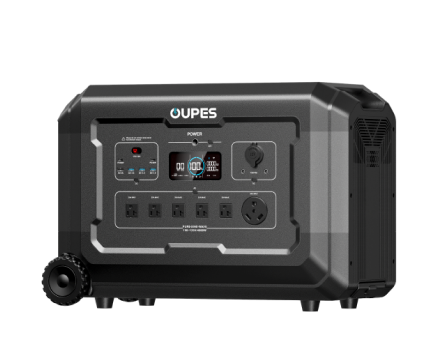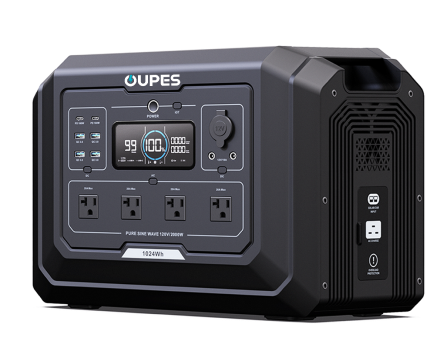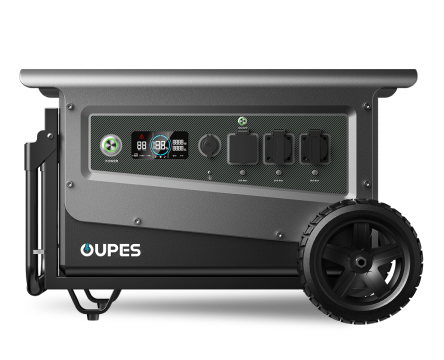
TL;DR / Key Takeaways
Winter power outages often bring greater danger than summer ones because of freezing temperatures, power infrastructure stress, longer restore times, and added health risks. According to the North American Electric Reliability Corporation (NERC), cold-weather forced outages rose significantly in recent winter storms. :contentReference[oaicite:1]{index=1} Urban and rural households alike face more acute risks of hypothermia, carbon-monoxide poisoning, burst pipes, and food spoilage. A portable backup system—such as a solar-capable unit from OUPES—can be life-saving when timed and sized correctly for winter loads.
Introduction: Seasonal Differences in Outage Risk
When the power goes out in the summer, we may sweat, lose refrigeration, or be without air-conditioning, but in the winter the consequences can be far more severe. The cold itself becomes a hazard. Heating systems may fail just when you need them most. Roofs may accumulate snow, which can lead to structural issues or downed lines. Outdoors work becomes dangerous. This article guides you through the reasons winter outages are more dangerous, the scenario-based risks you face at home, and how to prepare—with a focus on intelligent backup power solutions like those from OUPES.
Why Winter Outages Pose Higher Risks
1. Cold Temperatures Multiply Hazards
Winter outages mean you lose heating at the same time your body needs protection from the cold. Hypothermia and frostbite become genuine risks inside your home if temperature drops significantly. Equipment failures in the grid can push systems beyond their design during cold snaps—generators freeze, fuel supply lines become blocked, and overall reliability drops. For example, NERC found that forced outages in generation units increased sharply in extreme cold weather events. :contentReference[oaicite:3]{index=3}
2. Infrastructure Stress and Prolonged Restore Times
Ice, snow and freezing rain bring unique issues—not just heat overload as in summer. Power lines may sag under heavy ice, trees may break branches under snow load and fall on lines. These conditions often impede restoration crews. A review by Climate Central found that winter weather (including snow, ice, and freezing rain) accounted for about 23% of weather-related outages from 2000-2023—while less frequent than summer storms, they often lasted longer and affected remote areas severely. :contentReference[oaicite:5]{index=5}
3. Heating Systems & Fuel Supply Are Vulnerable
During winter, many homes rely on electric or gas heating. When the grid fails, the heating stops. Additionally, fuel supply systems (natural gas, propane) may become impaired by cold and freeze-offs, reducing heating options. One analysis noted that freezing conditions threaten not only grid generation but fuel infrastructure itself. :contentReference[oaicite:6]{index=6}
4. Added Secondary Risks: Pipes, Carbon Monoxide, and Food Spoilage
Winter outages bring secondary dangers:
- Burst pipes: Without heat, indoor plumbing may freeze and burst, leading to water damage and sanitation issues.
- Carbon monoxide (CO) risk: People may resort to unsafe heating methods (like indoor grills or non-vented heaters), risking CO poisoning.
- Food spoilage: Freezers and refrigerators lose power, and thawing food may spoil in the cold, leading to foodborne illness.
These risks compound the absence of electricity, turning a blackout into a full-blown emergency scenario.
Scenario-Based Challenges: Home Users in Winter
Urban Apartment Scenario
Imagine living in a multi-unit apartment in winter when the power goes out. The heating system may be centralized and dependent on electricity or forced-air fans to distribute heat. Without power:
- Indoor temperature falls rapidly.
- Windows and doors may leak cold air, increasing demand for heat you don’t have.
- Storage space for backup power may be limited—no garage, only balcony or closet space.
In this scenario, a compact but capable portable power station (for example from OUPES) rated for heating loads and with enough battery capacity to keep a space heater and essential electronics running for several hours can mean the difference between comfort and a health hazard.
Rural Cabin or Home Scenario
Now picture a rural home during a winter storm: heavy snow, downed lines, rural grid takes time to dispatch crews. Additional factors:
- Distance from service crews means repair may take days.
- Heating may rely on electric pumps or fans, or even require stored fuel generators.
- Driveways may be blocked, delaying fuel delivery or technician access.
In such a scenario, you need a robust backup system: a large-capacity portable power station with solar input (so you are not entirely fuel-dependent), proper indoor heating loads, and plans for staying safe for a longer period without grid power.
Winter vs. Summer Outages: Comparison Table
| Factor | Winter Outage | Summer Outage |
|---|---|---|
| Primary Risk | Hypothermia, freezing pipes, CO poisoning | Heat stroke, dehydration, air-conditioning failure |
| Infrastructure Cause | Ice/snow damage, fuel supply freeze, generation failures in cold | Overload demand, heat-wave, wildfire risks |
| Restore Time | Often longer (remote access, heavy ice removal) | Often shorter (fan crews, lighter damage) |
| Heating/Cooling Load | High heating demand, possibly no backup | High cooling demand, but may have alternative fans |
| Indoor Air Quality Risk | High (CO poisoning, dampness) | High (heat-stress, outdoor air) |
| Backup Power Strategy | High-capacity, long-runtime, solar backup preferred | Mid-capacity, shorter-runtime, cooling alternatives possible |
Preparing Your Home with a Backup Power Solution
Given the heightened risks winter outages pose, here is a user-guided preparation plan using a portable power station from OUPES:
Step 1: Identify Critical Loads
Make a list of what must keep running during an outage:
- Space heater (if used), or electric heating fan
- Refrigerator/freezer
- Communication devices (router, phone charger)
- Lights and maybe small fan for ventilation
Once you know the wattage of each, you can calculate battery size.
Step 2: Choose the Right Size Portable Power Station
Winter loads tend to be higher than summer loads because heating draws more power. You’ll want:
- High continuous power output (in kW) to handle heater/pump startup.
- Large battery capacity (in kWh) to cover multiple hours—and ideally days—of outage.
- Solar input or recharge capability if you expect long outages.
For example, a system rated for 3 kW continuous output and 10 kWh battery capacity would better cover a winter home backup than a smaller 800 W/1 kWh unit.
Step 3: Indoor Safe Use & Ventilation
Ensure the power station is used in a well-ventilated space, not in enclosed rooms where heat buildup or CO may accumulate. Also:
- Keep a carbon-monoxide alarm active.
- Ensure any heating element is safely rated and stable.
Step 4: Recharging and Maintenance
During a winter outage, recharging from solar may be limited due to shorter daylight and snow coverage. Hence:
- Ensure you begin outage with fully charged station.
- If solar inputs are used, keep panels clear of snow and angled for winter sun.
- If your station is used seasonally (e.g., cabin), store at ~50% charge, in moderate temp, to preserve battery health.
Step 5: Test & Drill Ahead of Time
Don’t wait until the outage hits. Run a drill in autumn: unplug grid for an hour, run your backup loads and station so you know how long it lasts and what adjustments you need.
FAQ
1. Why are winter power outages more dangerous than summer ones?
Because cold exposure multiplies risks—freezing conditions, heating failure, fuel supply freeze, burst pipes, long restore times, and indoor CO risk all converge.
2. Can a portable power station really make a difference in winter outages?
Yes. Especially when sized correctly and used safely. A unit from OUPES with sufficient capacity and high output can keep essential loads running until grid power returns.
3. Should I rely on solar panels for backup during winter?
Yes—but with caution. Winter daylight is limited and snow may block panels. Solar is a great supplement if you clear panels and begin with full battery.
4. How often should I maintain my backup power station for winter readiness?
Check quarterly during the off-season: charge to ~50 %, store in moderate temp, test full load a month before winter begins.
5. What size battery do I need for winter outage backup?
It depends on your loads and duration, but aim for at least several hours’ worth of essential heating plus battery capacity to remain safe. Bigger is better in winter than summer.
Conclusion
Winter power outages are far more than “just losing the lights.” They carry heightened risks due to freezing temperatures, heating failures, infrastructure stress, and longer restore times. By proactively preparing—identifying critical loads, selecting the right-sized portable power station from OUPES, ensuring safe indoor use, recharging strategies, and testing—you can turn a blackout into a manageable inconvenience rather than an emergency. Stay powered, stay safe.

